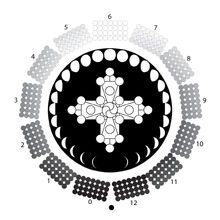m (→Leap Year Rule) Tag: Visual edit |
m (Xilanqa moved page Abysmal Calendar to TheAbysmal Calendar over redirect: the calendar's name is fully "theAbysmal Calendar") |
Revision as of 19:10, 29 December 2018
The Abysmal Calendar synchronizes existing calendars already in use, and provides a culturally-neutral alternative to the Gregorian as the world's de facto daykeeping system. It combines an observational lunar calendar with a rules-based solar calendar and harmonizes them with the changes to the position of the Sun throughout the Year.

Cardinal Numbering
Every measure of theAbysmal Calendar begins with 0, and counts time only after it has completely elapsed. This is an extension of the way we count seconds, minutes, hours to measures of the days, weeks, months, years, and so on.
Observational Lunar Calendar
theAbysmal Calendar harmonizes Unix Time, a linear count of seconds, the Julian Day, with the lunar month and the year. This provides the dataset by which any given date can be located within the observed cycles of the Earth, Moon, and Sun.
Starting with:
- second 00 = midnight UTC December 21st 2012 CE at 180 degrees longitude (IDL)
- Day 0 = December 21st 2012 CE
- Lunar Month 0 = December 12th 2012 to January 10th 2013 CE
- Year 0 = December 21st 2012 to December 20th 2013 CE
As this is the observational function of the calendar, scientific measure of planetary synodic cycles, meteor showers, comets, Solstices, Equinoxes, aphelion, perihelion and so on are all recorded here.
13~Month Calendar
theAbysmal Calendar has a rules-based annual calendar, which divides the year into 13 months with 1 day outside of any month, which falls on the Southern Solstice, December 21st on the Gregorian Calendar.
This creates a symmetrical structure aligned with the seasons of the year, as well as harmonizing the 7-day week with the month, the quarter, the semester, and the year.
As the calendar is strictly numeric, anyone is free to name the days, weeks, months, years, etc. however they choose.
Structure of the Year
365 = 364 + 1 = 7 x 52 + 1 = 7 x 4 x 13 + 1
Dividing the year in this manner allows us to make regular divisions of the year.
- 52 weeks + 1 day = 1 year
- 26 weeks = 1 semester
- 13 weeks = 1 quarter
- 4 weeks = 1 month
- 2 weeks = 1 fortnight
Each of these measures fits evenly into the year, + 1 day.
This also makes each of these a regular measure, which is a significant drawback of the Gregorian.
- 1 week = 7 days
- 1 fortnight = 14 days
- 1 month = 28 days (4 weeks)
- 1 quarter = 91 days (13 weeks)
- 1 semester = 182 days (26 weeks)
- 1 year = 364 days (52 weeks) + 1 day
Days of the Week
theAbysmal Calendar has no authority over the Days of the Week, however, an underlying 28-year pattern between the Days of the Week and theAbysmal 7-day week. New Year 0 fell on a Friday, making Month 0 Day 0 a Saturday. For the duration of year 0, every fortnight, month, quarter, and both semesters began on Saturday. Year 1 began on Sunday, and so every fortnight, month, quarter, semester began on Sunday, and so on.
Leap Year Rule
365 + 1/4 - 1/28
This aligns the Calendar Year most closely with the Tropical year.
The Leap Year Day falls on the Day before the New Year's Day (December 20th on the Gregorian).
Leap Year Day 0 fell on December 20th 2016 CE, the day before New Year's Day 4.
Notation
Numbering begins with 0, largest to smallest left to right, and punctuates notation as follows:
- dates are separated by tilda (~)
- times are separated by colon (:)
- anything less than a second is a decimal (.)
Example:
4~7~0 22:34:59.22
Year 4 Month 7 Day 0
10:34PM and 59.22 seconds.
See also
External links
- [[1]]